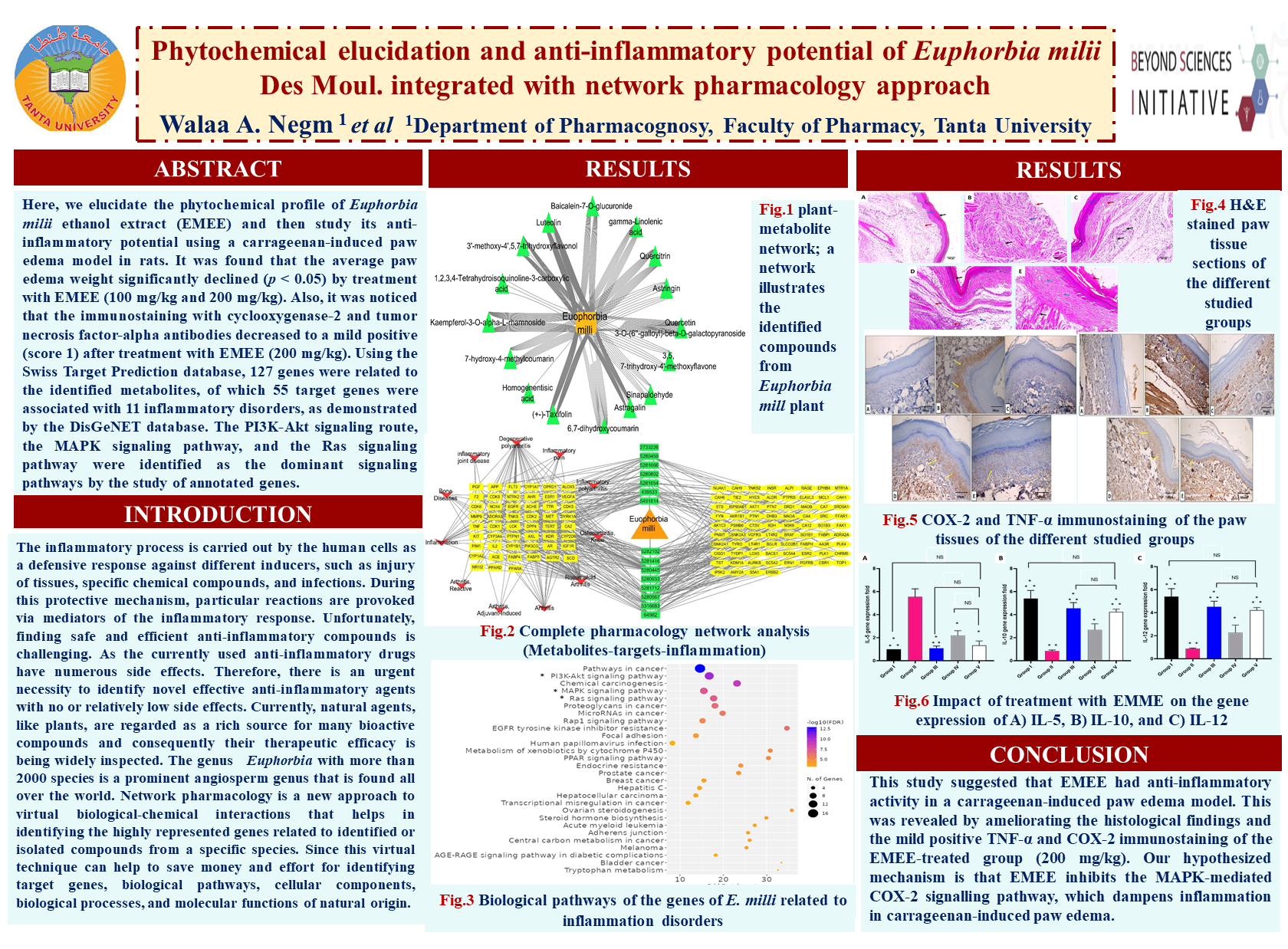Walaa Negm
Conference 2024 Poster
Poster Title
Phytochemical elucidation and anti-inflammatory potential of Euphorbia milii Des Moul. integrated with the network pharmacology approach.
Authors and Affiliations
Walaa A. Negm 1*, Engy Elekhnawy 2, Fatma A. Mokhtar 3, Reem Binsuwaidan 4, Nashwah G. M. Attallah 5, Sally Abdallah Mostafa 6, Ehssan Moglad 7, Sarah Ibrahim 8, Omnia Momtaz Al-Fakhrany 2, and Duaa Eliwa 1
1 Department of Pharmacognosy, Faculty of Pharmacy, Tanta University, Tanta 31527, Egypt
2 Department of Pharmaceutical Microbiology, Faculty of Pharmacy, Tanta University, Tanta 31527, Egypt.
3 Department of Pharmacognosy, Faculty of Pharmacy, El Saleheya El Gadida University, El Saleheya El Gadida 44813, Sharkia, Egypt
4 Department of Pharmaceutical Science, College of Pharmacy, Princess Nourah bint Abdulrahman University, Riyadh 11671, Saudi Arabia
5 The Egyptian Drug Authority (EDA), Previously NODCAR, Giza 8655, Egypt
6 Department of Medical Biochemistry and Molecular Biology, Faculty of Medicine, Mansoura University, Mansoura, Egypt
7 Department of Pharmaceutics, College of Pharmacy, Prince Sattam bin Abdulaziz
University, P.O. Box 173, Alkharj 11942, Saudi Arabia.
8 Human anatomy and embryology Department, Faculty of medicine, Tanta university Tanta 31527, Egypt.
* Correspondence: walaa.negm@pharm.tanta.edu.eg
Abstract
Background
The inflammatory process is carried out by the human cells as a defensive response against different inducers, such as injury of tissues, specific chemical compounds, and infections. During this protective mechanism, particular reactions are provoked via proinflammatory mediators.
Methods
For the first time, we elucidate the phytochemical profile of Euphorbia milii ethanol extract (EMEE) then investigate the anti-inflammatory activity of EMEE in carrageenan-induced paw edoema in rats after elucidating its secondary metabolites activity via network pharmacology using NCBI Gene database, DisGeNET database, network analysis programme Cytoscape, and Shiny Go database.
Results
The average paw edoema weight substantially declined (p < 0.05) by treatment with EMEE (100 mg/kg and 200 mg/kg). Also, the immunostaining with cyclooxygenase-2 and tumour necrosis factor-alpha antibodies decreased after treatment with EMEE (200 mg/kg), with improvement in the histological findings after examination of the paw tissues with hematoxylin and eosin, as it revealed a decrease in inflammation. EMEE (200 mg/kg) resulted in a significant decline (p < 0.05) in the levels of the proinflammatory mediators (granulocyte-macrophage colony-stimulating factor, monocyte chemoattractant protein-1, inducible nitric oxide synthase, and interleukin-5). Interestingly, it resulted in a substantial increase in (IL-10 and IL-12).
Conclusions
Using the Swiss Target Prediction database, 127 genes were related to the identified metabolites, of which 55 target genes were associated with 11 inflammatory disorders.
Our study suggested that EMEE had anti-inflammatory activity in a carrageenan-induced paw edema model in rats. This was revealed by ameliorating the histological findings as well as the mild positive TNF-α and COX-2 immunostaining of the EMEE-treated group (200 mg/kg). Our hypothesized mechanism is that EMEE inhibits the MAPK-mediated COX-2 signaling pathway, which dampens inflammation in carrageenan-induced paw edema. EMEE, therefore, requires more clinical research. Therefore, EMEE requires further clinical investigations as an anti-inflammatory agent.


Leave A Comment